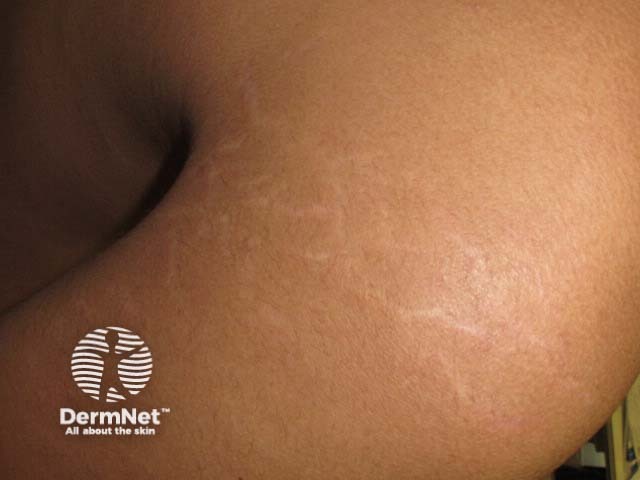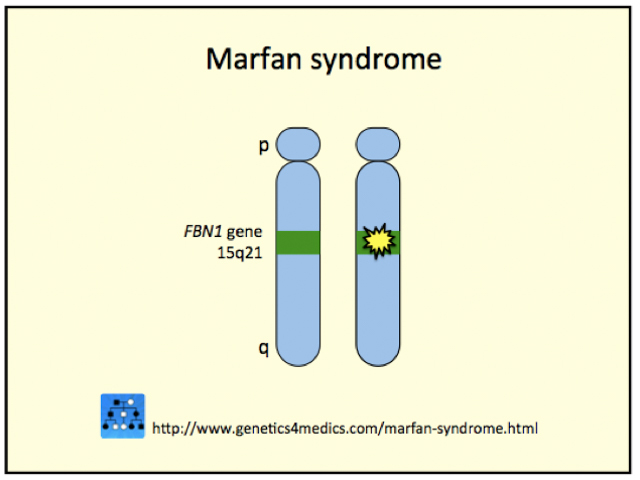Main menu
Common skin conditions

NEWS
Join DermNet PRO
Read more
Quick links
Marfan syndrome — extra information
What is Marfan syndrome?
Marfan syndrome is a connective tissue disorder that mainly affects the bones and joints (skeletal system), heart and blood vessels (cardiovascular system), and the eyes. Connective tissue is an essential component of the human body as it holds the body together and provides a framework for growth and development.
The main characteristic features of the syndrome include:
- Tall and thin stature with long extremities (arms, legs, fingers and toes disproportionately long in relation to rest of the body),
- Eye problems where one or both lenses of the eye may dislocate,
- Heart and blood vessel problems that may result in heart murmurs, irregular heartbeat, or in severe cases aortic aneurysm (potentially fatal heart condition).
Other systems that may be affected include the lungs, nervous system and the skin.
Striae in Marfan syndrome


What causes Marfan syndrome?
Marfan syndrome is caused by a defect in the gene on chromosome 15 that determines the structure of fibrillin, a protein that is a major component of elastin-associated microfibrils. These microfibrils are found in most connective tissue but are abundant in large blood vessels and the suspensory ligaments of the lens. Hence the most prominent features of Marfan syndrome are cardiovascular (heart) and ocular (eye) abnormalities.
Marfan syndrome is inherited in an autosomal dominant manner, which means that if one parent is affected with Marfan syndrome there is a 50% chance that each child will be affected. There are cases where neither parent is affected but they produce a child with Marfan’s syndrome. This de novo or spontaneous mutation occurs in 1 in 4 of all cases of Marfan syndrome.
Marfan syndrome is estimated to affect about 1 in 10,000 individuals.

Genetics of Marfan syndrome*
*Image courtesy Genetics 4 Medics
What are the skin features of Marfan syndrome?
The signs and symptoms experienced by people with Marfan syndrome vary greatly. Some patients may have a partial form of the syndrome and suffer mild symptoms while others with the full syndrome are more severely affected.
Skin findings, although not essential for the diagnosis of Marfan’s syndrome, are often present in patients. Skin features appear as striae or stretch marks that develop even without any significant weight change or pregnancy. They tend to appear at sites subject to stress such as the shoulders, hips, buttocks, and lower back, and may occur at any age. These stretch marks are not a problem to health and do not require any treatment.
Another feature to be aware of when examining the skin is a bulge around the stomach or groin area. This may be an abdominal or inguinal (groin) hernia that contains part of the intestines. Marfan syndrome patients are at greater risk than normal for developing these.
How is Marfan syndrome diagnosed?
The diagnosis of Marfan syndrome is based upon family history, physical examination and the presence of certain diagnostic criteria. The diagnostic criteria are divided into major criteria and minor criteria.
Major criteria are heart, lens and skeletal abnormalities that are highly specific for Marfan syndrome and rarely occur in the general population.
Minor features are often present in patients with Marfan syndrome, but also seen commonly in the general population. Skin features fall into the minor criteria grouping.
How is Marfan syndrome treated?
There is no specific treatment for Marfan syndrome. A cardiologist, ophthalmologist and orthopaedic surgeon should review patients with Marfan syndrome regularly. Early identification and intervention of risk factors, such as aortic dilation, should prevent or delay complications. With early diagnosis and preventative management a person with Marfan syndrome should expect to have similar life expectancy to that of the average person.
References
- OMIM – Online Mendelian Inheritance in Man (search term Marfan syndrome)
- Marfan Syndrome — GeneTests GeneReviews
- Book: Textbook of Dermatology. Ed Rook A, Wilkinson DS, Ebling FJB, Champion RH, Burton JL. Fourth edition. Blackwell Scientific Publications.
On DermNet
Other websites
- Marfan Syndrome — Medscape Reference
- National Marfan Foundation
